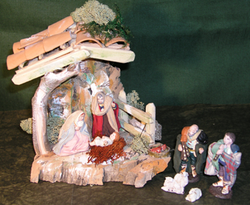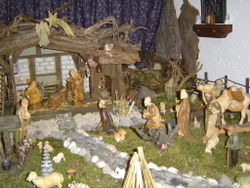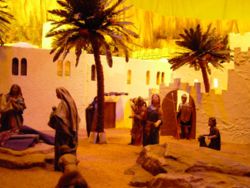
A nativity scene, also called a crib or crèche (meaning "crib" or "manger" in French) generally refers to any depiction of the birth or birthplace of Jesus. In Spain and some hispanic countries, this is called Belén (meaning Bethlehem in Spanish). In Argentina it is called pesebre, similar to Catalan (pessebre), and in Mexico is known as nacimiento (in fact, 'pesebre', 'nacimiento' and 'Belén' can be used interchangeably in most Spanish speaking countries).
Christian Nativity scenes, in two dimensions (drawings, paintings, icons, etc.) or three (sculpture or other three-dimensional crafts), usually show Jesus in a manger, Joseph and Mary in a barn (or cave) intended to accommodate farm animals. A donkey and an ox accompany them; besides the necessity of animals for a manager, this is an allusion to Isaiah: "the ox knoweth his owner, and the ass his master's crib; but Israel doth not know, my people doth not consider" (Is. 1:3). The scene sometimes includes the Magi or Three Wise Men, shepherds, angels and the Star of Bethlehem. The traditional scenes that show the shepherds and Magi together are of course not true to the Bible story, since the Magi arrived much later (Luke 2:7-16).

At Christmas time these arrangements are created and displayed in Catholic (and some Protestant) homes, churches and parks.
For the Christmas season, two Nativity Scenes are put on display at the Vatican. The first is put inside the Vatican Basilica. The second, placed in the Piazza San Pietro before the Christmas Tree, was made by Saint Vincent Pallotti.
Although St Francis of Assisi is credited with the invention of three-dimensional Nativity Scenes, drawings and paintings existed earlier. The tradition was brought into Spain from Naples during the reign of Charles III of Spain.

In Provence, in the South of France, nativity scenes are sometimes composed of hundreds of small painted clay figurines, called santons, representing all the traditional trades and professions of old Provence. Because of their cultural value the santons are often collected as art or craft objects, regardless of their possible use in a nativity scene.

In Mexico and in certain parts of Central America, it is traditional to build the Nativity Scene on December 16, the day of the first Posada. Traditionally, the Three Wise Men are not included in the Nativity Scene until January 6, Three King's Day. The Nativity Scene is not taken until February 2, Candlemas, which marks the end of the Epiphany season.
In some places in Spain, such as Parets del Vallès, monumental indoor nativity scenes are built. They can be as big as 280 m², using more than 12,000 Kg of sand, 3,000 Kg of stones, 1,500 Kg of cork, and more than 800 figures. Light effects, water streams, rain, music, and atomatons are used to give a realistic touch to the scene.
External links
Categories: Christmas traditions
